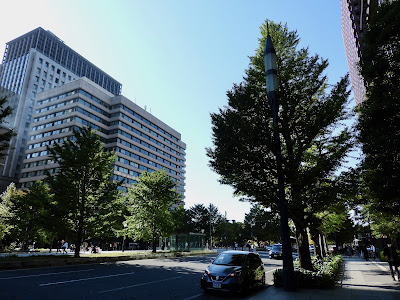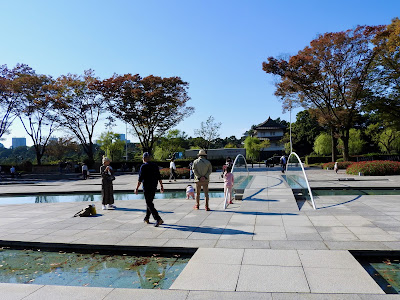目次 / Contents
1) 東京へ行く / Go To Tokyo
2) 丸の内 / Marunouchi
3) 和田倉橋 / Wadakura Bridge
4) 和田倉門 / Wadakura Gate
5) 和田倉噴水公園 / Wadakura Fountain Park
1) 東京へ行く / Go To Tokyo
友人、堀内君のグループ展を見に、夫Rとともに東京へ行きました。
展覧会のチラシ、カタログのデザインも堀内君がしました。
ですが、観光をかねて、東京駅から皇居のお濠端 (ホリバタ/ 大手濠 : オオテボリ) を歩いて向かう方法を取りました。
このセクションは皇居のお濠までの道のりについてで、グループ展については、のちのセクションに載せます。
グループ展について下記。
Go To Tokyo
I went to Tokyo with my husband R to see a group exhibition of my friend Horiuchi Kun.
He also designed the leaflet and catalogs for the exhibition.
The venue for the exhibition was inside the Mainichi Shimbun Tokyo Headquarters in Takebashi, Tokyo.
From Kamakura, take the Yokosuka Line and get off at Tokyo Station, then change to the Tokyo Metro Tozai Line and get off at Takebashi Station, which is the closest route to the venue.
However, as sightseeing, we took a way of walking from Tokyo Station to the moat of the Imperial Palace; 'Ōte Bori: Ōte Moat'.
This section is about the area to the moat of the Imperial Palace, and later section will be about the group exhibition.
About the group Exhibition, below.
2) 丸の内 / Marunouchi
ですが、私には、'丸の内' は、地下鉄丸の内線 : ⭕️ の名前であり、東京駅周辺のオフィス街というイメージで、皇居と結びついてはいませんでした。
東京駅から皇居を意識して、皇居へ向かって歩いたのは初めでした。
 |
| 行幸通り 行幸通り (ギョウコウドオリ) は、皇居前の和田倉門交差点から 東京駅前の東京駅中央口交差点までを結ぶ特例都道です。 正式名は、東京都道404号皇居前東京停車場線。 密集するビル群である東京にあって、ここには解放感があります。 Gyoko-dori Street Gyoko-dori Street is a special prefectural road that connects the Wadakura-gate intersection in front of the Imperial Palace to the Tokyo Station Centre intersection in front of Tokyo Station. The official name is Tokyo Metropolitan Road No. 404 Imperial Palace Tokyo Stop Line. Gyoko means Imperial visit in Japanese. There is a feeling of liberation here, even though Tokyo is a group of densely packed buildings. |
Marunouchi
Marunouchi is a district between Kokyo Gaien National Garden and Tokyo Station.
However, to me, 'Marunouchi' was the name of
Tokyo Metro Marunouchi Line : ⭕️ , and I had the image of an office district around Tokyo Station, and it was not connected to the Imperial Palace.
This was the first time I walked toward the Imperial Palace from Tokyo Station, conscious of the Imperial Palace.
 |
| '民間'とは、三菱財閥の 岩崎弥之助 (イワサキヤスノスケ/ 1851 - 1908) 率いる"三菱社" です。 明治期には、'三菱ケ原'と呼ばれました。 下記、丸の内についてWikiより。 "そうした歴史的な経緯から三菱グループ各社の本社が集中し、 「三菱村」とも呼ばれる。 特に三菱グループの御三家といわれる 三菱UFJ銀行、三菱商事、三菱重工業の本社は 全て丸の内に位置している。 三菱地所が30棟もの高層ビルを所有しており、 丸の内の大家とも言われている。" オフィス街の元はここにあるわけですね。 |
 |
| According to Wiki about Marunouchi, "Those moved in 1890, and Iwasaki Yanosuke (1851 - 1908), brother of the founder (and later the second leader) of Mitsubishi, purchased the land for 1.5 million yen. As the company developed the land, it came to be known as Mitsubishi-ga-hara (the "Mitsubishi Fields"). Much of the land remains under the control of Mitsubishi Estate, and the headquarters of many companies in the Mitsubishi Group are in Marunouchi." The origin of the office district is here. |
 |
| 今日は祝日! 祝日に国旗を各家や各建物に掲げるのは日本の慣習でした。 けれども最近はあまり見かけませんし、自分でもしません。 私が子供の頃、父は玄関先に日の丸を掲げていました。 この日の丸を見て父の姿を思い出しました。 今日は何の祝日でしょうか? '文化の日'です。 Today is a National Holiday! It was Japanese custom to raise the national flag on each house and building on National Holidays. But I don't see many these days, and I don't do it myself. When I was a child, my father displayed the Hinomaru (National Flag)at the front door. Seeing the Hinomaru reminded me of my father. What holiday is it today? It's'Culture Day'. |
 |
恵比寿様! 東京海上日動ビル前です。 'くぐり恵比寿'という名前を後で知りました。 土台部分の間をくぐり抜けると幸せになると言われているそうな... 流 政之 (ナガレマサユキ:1923- 2018)作。 作者は零戦パイロットであった経歴を持ちます。 香川県にNAGARE STUDIO 流政之美術館 : ★があります。 God Ebisu! Ebisu is the Japanese God of fishermen and luck. This is in front of Tokio Marine & Nichido Building. Later I found the name 'Through Ebisu'. It seems that it is said that you will be happy if you go through the base part ... By Masayuki Nagare (1923-2018). The artist had a history of being a Zero Fighter pilot. There is 'NAGARE STUDIO ・Nagare Art Galley ' : ★ in Kagawa prefecture. 恵比寿といえば、エビスビール!と瞬く間に連想します(笑)。 この像を見たためなのか、この日の晩に、思っても見なかった、 'YEBISU BAR 銀座コリドー街店'へ行きました。 'YEBISU BAR 銀座コリドー街店'については、 のちのセクションに載せます。 Speaking of Ebisu, I immediately associated with YEBISU BEER! (Laugh). Perhaps because I saw this statue, we visited I hadn't imagined for this evening. "YEBISU BAR Ginza Corridor-gai" will be mentioned in a later section. |
エビスバーについては下記。
About the YEBISU BAR, below.
3) 和田倉橋 / Wadakura Bridge
 |
| 皇居外苑案内図 公式サイト : ★ (地図:★) Guide Map to Kokyo Gaien National Garden Kokyo means Imperial Palace. Official Website : ★ (Map : ★) |
行幸通りを皇居へ向かって歩いていると、お濠 (内濠: 和田倉濠) と
和田倉橋 (ワダクラバシ) に目が惹かれました。
江戸時代 (1603 - 1868) のデザインである和田倉橋は、近代的なビル群に囲まれています。
そこには、不思議な空間があり、しばし足を止めずにはいられません。
私もRもこの橋に魅了されて、歩くコースをかえ、橋を渡ることにしました。
 |
| 和田倉濠と和田倉橋 Wadakura Moat and Wadakura Bridge |
Wadakura Bridge
As we walked along Gyoko Street towards the Imperial Palace, we were attracted to the moat (Uchibori : Wadakura Moat) and Wadakura Bridge.
Wadakura Bridge, designed in the Edo Period (1603 - 1868), is surrounded by modern buildings.
There is a mysterious space there, and I can't help but stop for a while.
Both I and R were fascinated by this bridge and decided to change our walking route and cross the bridge.
 |
| 和田倉橋 1953年に3代目の和田倉橋は竣工しました。 この和田倉橋 : ★と平川橋は、江戸城木橋の形を復元した、 ただ二つの貴重な木橋です。 今日の目的の毎日新聞東京本社は平川橋近くにあります。 Wadakura Bridge The third Wadakura Bridge was built in 1953. the only two precious wooden bridges that have been restored to the shape of the Edo Castle wooden bridges. Today's purpose, the Mainichi Shimbun Tokyo Headquarters, is near Hirakawa Bridge. 現在と江戸時代の狭間にいるような 奇妙な感覚を持ちます。 It has a strange feeling as if it were between the present and the Edo period. |
 擬宝珠 |
| 欄干の装飾、擬宝珠 (ギボシ) は、復旧する以前の橋に 用いられていたものです。 この橋を渡った時は橋の先に何があるのかを知りませんでした。 Giboshi The balustrade decoration, Giboshi was used for the bridge before it was restored. When we crossed this bridge, we didn't know what was at the end of the bridge. 擬宝珠 / Giboshi |
 |
| 和田倉門跡に続いています。 和田倉門は、江戸城の守衛のために築かれた内郭門の1つです。 The bridge leads to the Wadakura-mon Gate ruins. Wadakuramon-Gate is one of the inner gates built to guard Edo Castle. |
 |
| 和田倉橋を渡った先には和田倉噴水公園があります。 和田倉噴水公園の北と東はお濠と城壁に囲まれています。 西は内堀通り (東京都道401号麹町竹平線 : 平川門交差点 - 九段下交差点)、南は行幸通りです。 Wadakura Fountain Park is just across the Wadakura Bridge. The north and east of Wadakura Fountain Park are surrounded by moats and walls. Uchibori Street is in the west and Gyoko Street is in the south. |
 |
| 赤線 : 内堀通り Red Line : Uchibori Street 'Uchibori' means 'Inside Moat' in Japanese. Uchibori Street is the nickname for the circular road around the Imperial Palace. 画像は下記より / This from below ★ |
4) 和田倉門 / Wadakura-mon Gate
下記、皇居外苑サイトより
"和田倉門は現在、門跡として石垣のみが残されています。
江戸時代は「蔵の御門」と呼ばれていた和田倉門は、一般人は通行できず、武士だけが通ることを許されていました。
徳川氏が江戸城に入った頃、この辺りを蔵地としたので、この名称をとったそうです。
「和田倉」と呼ぶようになったのは、慶長12年 (1607) 頃からと言われており、名の由来は、海の名称「わた」からきたもの。
日比谷の入り江がここに及び、その入江にのぞんで倉がならんでいたので、あわせてこの地を和田倉と呼ぶようになったそうです。"
According to their official website in Japanese,
(Translated by me)
"Today, only Ishigaki (stone walls) remain of Wadakuramon-Gate, as a Gate ruin.
Wadakuramon-Gate was called "Gate of Kura (storehouse) " in the Edo period, was not accessible to the general public, entry was only allowed to samurai.
When Tokugawa Clan entered Edo Castle, they used this area as storehouses, so they took this name.
It is said that it came to be called "Wadakura" from around 1607, and the name comes from the sea: Wadatsumi or Watatsumi which is Gods of the sea in Japanese mythology and in some cases, it refers to the sea or the ocean itself.
Hibiya inlet stretched out here, and storehouses (Kura) were lined up in the inlet, so it seems that this place was also called Wadakura."
 |
| 無料の休憩所 ガラス張りの綺麗な建物です。 現在は修理中で閉じられています。 Free Rest Building It is a beautiful glass-walled building. It is currently under repair and closed. |
公園は、穏やかな風景が広がっています。
人々はリラックスしているように見えました。
この公園から、'天皇の存在は日本人に心の平安を与える'という趣旨を感じました。
The park has a calm scene.
People seemed relaxed.
From this park, I felt that the existence of the emperor gives the Japanese people peace of mind.
 |
| 穴の部分が噴水になっています。 水が出るところは、私は見られませんでした。 The holes become a fountain. I couldn't see when the water comes out. |
 |
| 光の粒と水の粒が遊んでいます。 Grains of light and grains of water are playing.  体の中心から浄化されるように感じます。 I feel like I am purified from the centre of my body. |
東京で、こんな風に浄化された気持ちになることを期待していませんでした。
寄り道をして良かったと思えました。
和田倉噴水公園を出て、予定のコースに戻り、皇居のお濠 (桔梗濠と大手濠) に沿って、毎日新聞東京本社へ向かって歩きました。
思いのほか、このセクションが長くなってしまったので、お濠端については次のセクションに載せます。
I didn't expect to feel purified like this in Tokyo.
I'm glad we took a side trip.
After leaving Wadakura Fountain Park, we returned to our planned course and walked by the moat of the Imperial Palace (Kikyou Bori : Kikyo Moat and Ōte Bori : Ōte Moat) toward the Mainichi Shimbun Tokyo Headquarters.
This section has become longer than I expected, so I will post about the Moats in the next section.






















0 件のコメント:
コメントを投稿